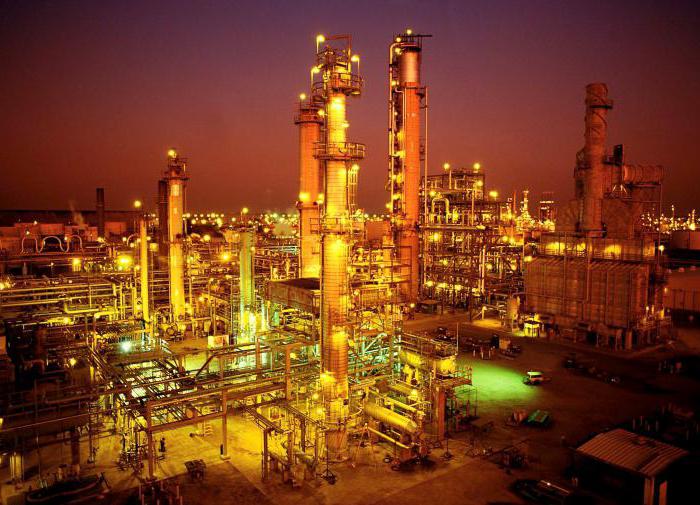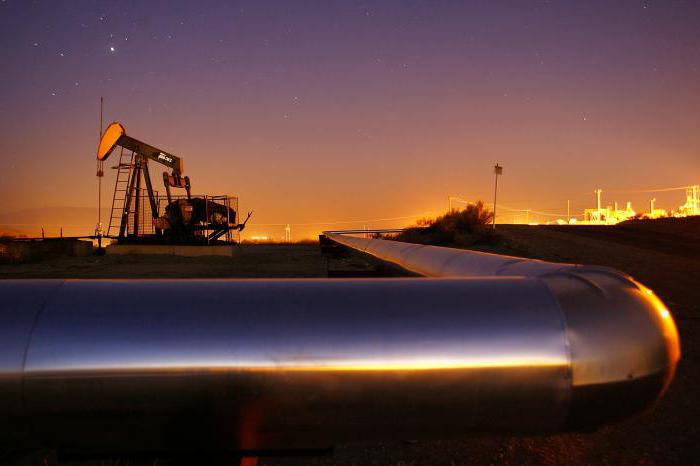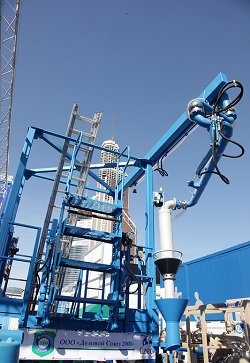Fuel resources provide energy not only to the entire industry of any country in the world, but also to practically all spheres of human life. The most important part of the fuel energy complex Russia is the oil and gas sector.
The oil and gas industry is a generalized name for the complex industrial enterprises for the production, transportation, processing and distribution of the final products of oil and gas processing. This is one of the most powerful industries Russian Federation, to a large extent shaping the budget and balance of payments of the country, providing foreign exchange earnings and maintaining the exchange rate of the national currency.
The history of development
The beginning of the formation of the oil field in industry it is considered to be 1859, when mechanical drilling of wells was first used in the United States. Now practically all oil is produced by means of wells with only a difference in production efficiency. In Russia, the extraction of oil from drilled wells began in 1864 in the Kuban. The production debit at that time was 190 tons per day. In order to increase profits, much attention was paid to the mechanization of extraction, and already at the beginning of the 20th century, Russia took a leading position in oil production.
The first major oil recovery areas in Soviet Russia were North Caucasus(Maykop, Grozny) and Baku (Azerbaijan). These dwindling older deposits did not meet the needs of the growing industry, and significant efforts were made to discover new deposits. As a result, several fields were put into operation in Central Asia, Bashkiria, Perm and Kuibyshev regions, the so-called Volga-Ural base was created.
The volume of oil produced reached 31 million tons. In the 60s, the amount of black gold mined increased to 148 million tons, of which 71% came from the Volga-Ural region. In the 70s, the fields of the West Siberian basin were discovered and put into operation. With the exploration of oil, a large number of gas deposits have been discovered.

The importance of the oil and gas industry for the Russian economy
The oil and gas industry has a significant impact on the Russian economy. At present, this is the basis for budgeting and ensuring the functioning of many other sectors of the economy. The value of the national currency largely depends on world oil prices. The carbon energy resources produced in the Russian Federation make it possible to fully satisfy the domestic demand for fuel, ensure the country's energy security, and also make a significant contribution to the world energy resource economy.
The Russian Federation has a huge hydrocarbon potential. The oil and gas industry of Russia is one of the leading in the world, fully satisfies the domestic current and future needs for oil and their refined products. A significant amount of hydrocarbon resources and their products are exported, providing replenishment of the foreign exchange reserve. Russia ranks second in the world in terms of liquid hydrocarbon reserves, with a share of about 10%. Oil reserves have been explored and developed in the depths of 35 constituent entities of the Russian Federation.

Oil and gas industry: structure
There are several structural core processes that make up the oil and gas industry: oil and gas production, transportation and processing industries.
- Extraction of hydrocarbons is a complex process that includes exploration of deposits, drilling of wells, direct production and primary purification from water, sulfur and other impurities. The production and pumping of oil and gas to the commercial metering unit is carried out by enterprises or structural divisions, the infrastructure of which includes booster and cluster pumping stations, water discharge units and oil pipelines.
- Transportation of oil and gas from production sites to metering stations, to refineries and to the final consumer is carried out using pipeline, water, automobile and railway transport... Pipelines (field and main) are the most economical way of transporting hydrocarbons, despite the very expensive construction and maintenance. Oil and gas are transported by pipeline transport over long distances, including different continents. Transportation by waterways using tankers and barges with a displacement of up to 320 thousand tons is carried out in intercity and international communications. Rail and trucks can also be used to transport crude oil over long distances, but are most cost effective on relatively short routes.
- The processing of raw hydrocarbon energy carriers is carried out in order to obtain various types of petroleum products. First of all, it is different types fuels and raw materials for subsequent chemical processing. The process is carried out at the refineries of the refinery. Final products of processing, depending on chemical composition are classified into different brands. The final stage of production is mixing the various components obtained in order to obtain the required composition corresponding to a certain

Deposits of the Russian Federation
The oil and gas industry in Russia includes 2,352 developed oil fields. The largest oil and gas region in Russia is Western Siberia, accounting for 60% of all black gold mined. A significant part of oil and gas is produced in the Khanty-Mansiysk and Yamalo-Nenets Autonomous Okrugs. Production volume in other regions of the Russian Federation:
- Volga-Ural base - 22%.
- Eastern Siberia - 12%.
- Northern fields - 5%.
- Caucasus - 1%.
Share Western Siberia in natural gas production reaches almost 90%. The largest deposits (about 10 trillion cubic meters) are in the Urengoyskoye field in the Yamalo-Nenets Autonomous Okrug. Gas production in other regions of the Russian Federation:
- Far East - 4.3%.
- Volgo-Ural deposits - 3.5%.
- Yakutia and Eastern Siberia - 2.8%.
- Caucasus - 2.1%.

and gas
The challenge of refining is to turn crude oil and gas into marketable products. Refined petroleum products include heating oil, vehicle gasoline, jet fuel, diesel fuel. The refining process includes distillation, vacuum distillation, catalytic reforming, cracking, alkylation, isomerization, and hydrotreating.
The oil and gas industry in the world allows us to solve important economic, political and social problems. With a favorable situation on the world energy markets, many oil and gas suppliers are making significant investments in the national economy using their export earnings and are demonstrating exceptional growth dynamics. The most vivid examples can be considered the countries of South-West Asia, as well as Norway, which, with low industrial development, thanks to its hydrocarbon reserves, has become one of the most prosperous countries in Europe.

Development prospects
The oil and gas industry of the Russian Federation largely depends on the behavior of the main competitors in production on the market: Saudi Arabia and the USA. By itself, the total amount of hydrocarbons produced does not determine world prices. The dominant indicator is the percentage of production in a given oil power. The cost of production of 1 barrel in different leading countries in production varies significantly: the lowest in the Middle East, the highest in the United States. With an imbalance in the volume of oil production, prices can change both in one direction and in the other direction.
The oil and gas industry in Russia is not only the extraction of resources from the bowels of the earth, but also a system of complexes for fuel purification and production of products. A huge role in the industry is assigned to specialized technical equipment and technologies. All this can be found at the annual Neftegaz exhibition organized by Expocentre. More than 20 thousand craftsmen of the relevant industry segment, representatives of companies that manufacture equipment for mineral processing, gather under one roof during the exposition. This made the "Neftegaz" exhibition not just the central event of the oil and gas industry, but also brought it to the international level. The event is attended by domestic and foreign companies that are leaders in their field.
About one third of the world's natural gas reserves are concentrated on the territory of the Russian Federation. By and large, the bulk of the fields are located in the eastern part of the country, which account for 84% of the gas produced. For the convenience of transportation, a gas supply system was created in the state, which unites compressor stations, a network of gas pipelines, resource storage facilities and fields.
In terms of oil reserves, Russia is inferior to only five states. But even this is more than enough to develop this segment of production. Oil transportation, as in the case of gas, is assisted by an oil pipeline system. Practice has shown that this is the most efficient transport complex in the Russian oil and gas industry.
The role of the oil and gas industry in the Russian economy
In fact, many consider this industry to be a strategic outpost of the state: it is both the basis for ensuring the country's stability and the basis for the development of its economy. It so happened that modern world fuel dependent: vehicles they travel thanks to petroleum products, polymers are made from natural gas, some medicines, even a toy in the hands of a baby is the result of processing minerals.
All this, without exaggeration, makes gas and oil the most useful and valuable resources not only fuel industry but also other areas. Therefore, the oil and gas industry plays a leading role in the Russian economy. The gas and oil complexes are closely related to other sectors of the economy and production of the state. The commodity structure of domestic and international trade is full of gas and oil refined products. Fossils are significantly ahead of other items of export and import. The commercial energy balance is highly dependent on oil and natural gas production. So, if we recalculate in oil equivalent, gas and oil account for about 60% of the world's consumption of energy sources.
Thanks to all this, the oil and gas industry plays a key role in the Russian economy.
The main enterprises of the oil and gas industry in Russia
One of the main sectors of the exhibition is considered to be a series that presents professional equipment for the extraction of minerals and their processing. Manufacturers of technical equipment for the structures of the oil and gas industry take the Neftegaz exhibition very seriously, and therefore present high-quality equipment. All of it is used by the largest enterprises of the oil and gas industry in Russia:
- LUKoil;
- Rosneft;
- Surgutneftegaz;
- Gazprom.
Each of the gas and oil giants plays a big role for the country. At the same time, all companies are able to solve the most difficult tasks at the state level. But at the same time, their activities are not complete without the support of small enterprises that are engaged in exploration, installation work, and companies that are engaged in maintenance and construction of new towers, laying and repairing pipelines.
 Without exaggeration, the largest oil producer in the country is this moment LUKoil. The company is engaged not only in exploration work, resource extraction, but also in the processing of fossil fuels and the sale of petroleum products. The Russian brand entered the list of the largest trade marks on the planet. At the same time, LUKOIL ranks first in the world in terms of oil reserves (according to the company's internal sources).
Without exaggeration, the largest oil producer in the country is this moment LUKoil. The company is engaged not only in exploration work, resource extraction, but also in the processing of fossil fuels and the sale of petroleum products. The Russian brand entered the list of the largest trade marks on the planet. At the same time, LUKOIL ranks first in the world in terms of oil reserves (according to the company's internal sources).
But in the field of gas production at the moment OJSC "Gazprom" dominates. The organization is considered the largest structural entity in the world for the production of natural gas. It should be noted that the monopoly provides the country with fuel by about 94%. OJSC Gazprom is rightfully considered the largest gas company in the world. At the same time, it owns the longest gas pipeline system.
Development of the oil and gas industry in Russia in the XXI century
According to the state energy strategy, the long-term development of the oil and gas industry in Russia involves the solution of the following issues:
- Rational consumption of existing reserves of minerals;
- Extended application raw material base oil and gas industry;
- Development of an energy-saving structure;
- Rational transportation and resource conservation;
- Maximum use of all useful components in oil and gas processing;
- Construction of new mining centers.
At the moment, the oil and gas industry in Russia is a powerful conglomerate that spreads its influence not only on the territory of the state, but also far beyond its borders. But even being a fairly developed structure, the Russian oil and gas industry requires development and capital investment.
Read our other articles.
TASS-DOSSIER. On April 18-21, 2016, Moscow will host the 16th international exhibition "Neftegaz-2016". The editorial staff of TASS-DOSSIER has prepared a certificate on the state of the Russian oil and gas industry.
Production volumes
At the end of 2015, Russia produced 534.1 million tons of oil (including gas condensate), which is 1.5% more than in 2014 and 5.3% more than in 2010.
At the same time, gas production in Russia is gradually declining. In 2015, 635.3 billion cubic meters were produced. m, which is 1% less than in 2014. The annual record for gas production was set in 2011 (671 billion cubic meters).
Share in world production
Russia is the second largest oil and gas producer in the world after the United States. According to the International Energy Agency (IEA), the share of the Russian Federation in world oil production is 11.2% (as of 2015), in gas production - 18.3% (as of 2014).
Stocks
As the head of the Ministry said in March 2015 natural resources and the ecology of the Russian Federation Sergey Donskoy, the volume of proven oil reserves in Russia is about 14 billion tons, these reserves, while maintaining the current level of production, should be enough for 28 years. Theoretical reserves, according to the Ministry of Natural Resources, are about 29 billion tons.
Explored gas reserves in Russia, according to the Central Dispatch Office fuel and energy complex (CDU TEK), are about 48-49 billion tons.
Large hydrocarbon reserves are concentrated on the Russian Arctic shelf. According to the Ministry of Energy of the Russian Federation, its recoverable explored reserves amount to 447 million tons of oil and 10.1 trillion cubic meters. m of gas.
Major mining companies
The largest oil company Russia is Rosneft (about 40% of production), followed by Lukoil (16.3%), third place is shared by Gazprom Neft and Surgutneftegaz (10-11%).
In gas production, Gazprom accounts for 72%, another 11% is the share of Novatek.
Export
In 2015, Russia, according to Transneft (a monopoly in the field of main oil pipelines of Russia), exported 244.5 million tons of oil (45.7% of production). Gas exports in the same year amounted to 200.9 billion cubic meters. m (34.8% of production).
The main importers of Russian oil, according to the Federal Customs Service of the Russian Federation for the first half of 2015, are the Netherlands (18.3%), China (16.9%) and Italy (8.8%). The main importers of Russian gas in 2015, according to Gazprom, are Germany (about 28%), Turkey (about 17%) and Italy (about 15%).
Oil refining
At the end of 2015, the volume of primary oil refining in Russia amounted to 287 million tons, which is 2.7% less than in 2014. 30% of refining falls on Rosneft, 16% - Lukoil, 14% - " Gazpromneft ".
Share of oil and gas revenues in the budget and GDP
According to the Ministry of Finance of the Russian Federation, the share of oil and gas revenues in the budget of the Russian Federation as of March 2016 is 37.4%. For comparison, in 2015, oil and gas revenues brought the budget 5 trillion 862.7 billion rubles. (42.9% of total revenues), in 2014 - 7 trillion 433.8 billion rubles. (51.3%).
The share of oil and gas revenues in GDP is also gradually declining. In 2010, according to Finance Minister Alexei Kudrin, it reached 25%. In November 2015, the Speaker of the State Duma of the Russian Federation Sergey Naryshkin reported that the share of the oil and gas sector in GDP by the end of 2015 had fallen below 10%.




